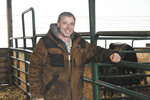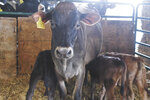

CLAREMONT, Minn. — Dwight Burkholder has found a successful, long-term calf feeding solution for his dairy farm using nurse cows.
“This is only one way of many right ways to feed calves,” Burkholder said. “There would be many good reasons not to do it this way.”
Burkholder milks 60 cows on a grass-fed dairy along with his wife, Darla, and their four youngest children: Meredith, Matthew, Micah and Angela.
Burkholder has fed calves using nurse cows since 2017. He calves seasonally during March and April and occasionally into May.
Burkholder keeps 20-24 heifer calves per year. These calves require 7-8 nurse cows.
For the Burkholders, using nurse cows has helped solve post-weaning slumps, cross sucking and labor issues.
“The labor of feeding calves has just literally evaporated,” Burkholder said.
Burkholder said this is an expensive way to feed calves, but that this method satisfies what he and his family were after.
“So much of that potential is set in those first months, that how do you possibly put a dollar figure on that?” Burkholder said.
Money was not the main driver behind the decision to use nurse cows.
“That wasn’t the calculation when we started,” Burkholder said. “We’re not ‘bottom dollar’ (people). ... We’re more about lifestyle and things making sense management-wise.”
Burkholder originally raised calves in individual calf hutches. In 2006, after they switched to grazing and seasonal calving, they moved to mob feeding.
Burkholder said while this was not a bad way, mob feeding was time-consuming. It took two people the entire milking time to feed calves.
When one calf got sick, the entire pen would get sick. Milk temperature was a challenge as well. They fed half fresh, unpasteurized milk and half milk replacer made with hot water to warm the milk.
One of the most frustrating issues Burkholder said was cross sucking. The Burkholders used various methods to eliminate the practice such as following the milk with warm water, switching nipples frequently and using weaners.
“I hated it; I just dreaded all this stuff,” Burkholder said.
Burkholder said they wanted to keep their calves on milk for 12 weeks, but often by 8-9 weeks, they were burned out with the calf feeding chores and would wean the calves. The post-weaning slump was an issue as well.
“No matter what we did ... the calves would go from nice-looking fat, fleshy, beautiful calves to sort of scrawny,” Burkholder said. ... “They just didn’t look as thrifty.”
Burkholder said the calves were underdeveloped to utilize pasture when weaned.
“They couldn’t get the groceries they needed,” Burkholder said.
Burkholder began looking into alternative methods of feeding calves and found the nursing method.
“(You) need to have a cow that has milk in her udder and wants to be milked, and (you) need to have a hungry calf,” Burkholder said. “If you have those two things together, you’re going to succeed.”
Before he started, Burkholder invested in gates and infrastructure. Each group of 2-3 calves has a separate pen in a pole shed on bedded pack. Each pen resembles an oversized box stall with access gates. The cows are separate from the calves, with access to an outside lot and an open, bedded area in the middle of the box stalls.
Each nursing group usually includes a cow and her heifer, which Burkholder said makes everything calmer. However, he has convinced a cow into nursing calves that were not her own.
“We’re calving all the cows at once, ... so the motherly instincts are flowing,” Burkholder said.
Burkholder said he was warned that he might have to tie the cows for them to allow the calves to suck, but he said it is rare that he must do this.
“It went far easier than I would have ever dreamed,” he said. “It really was a cinch.”
Burkholder looks for nurse cows with motherly instincts. He also looks for cows that have a higher somatic cell count, are older or have poor udders. However, only a third or less of the nurse cows fit these categories.
Ill-tempered cows do not work. They vigorously kick the calves and make everyone’s lives miserable, Burkholder said.
The cows spend time with the calves twice a day. Each time, the cows, who get grain at that time, spend several hours with the calves.
“When we come back to let them out, everybody’s laying down, and everybody’s content and happy,” Burkholder said.
Within the first 10 days of May, Burkholder turns the nurse herd out to pasture. The calves continue to nurse and eat starter from a creep feeder and sample the pasture and baleage.
In August, the calves are weaned. Weaning is an unpleasant experience for the Burkholder family.
“We just have to clench our teeth and get through this, because it is bawling and carrying on like you wouldn’t believe,” Burkholder said. “All 20 calves and all eight of those cows are going to bawl for several days. It’s just a serenading.”
Burkholder said the calves will bawl for two days, but the cows, who seem to miss it more, will bawl for 1-2 weeks.
When the calves are weaned, they do not go through a slump.
Burkholder has found that getting his nurse cows bred back is difficult. He said if he gets three of the cows bred back, it is a success.
“It’s messing with their ovulation to some degree,” Burkholder said. “Their ability to settle is lessened, and they don’t show heats well.”
The Burkholders have tried ovsynch protocols, controlled intravaginal drug release and even a bull. None of them have been successful.
“I wish that I could have better success breeding these nurse cows back,” Burkholder said. “I’ve just finally come to peace that that’s not going to happen.”
Though Burkholder sees the downsides of his calf-feeding method, he is satisfied with the method for his family’s farm.
“I always come back to, ‘Can you improve on what God has made?’” Burkholder said.
Burkholder said he has concluded after seven years of using this method that the natural system is difficult to improve.
Comments
No comments on this item Please log in to comment by clicking here